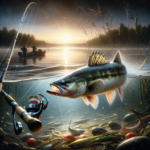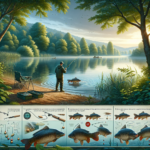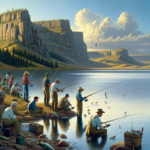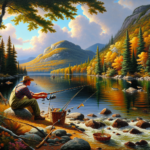Fishing Tips on How to Catch Bowfin

Introduction
Bowfin, also known as Amia calva, is a fascinating and ancient fish species that has captured the interest of many anglers. Known for their aggressive behavior and strong fighting ability, bowfin are a prized catch in sport and recreational fishing. This article aims to provide comprehensive tips and techniques for catching bowfin, covering everything from their physical characteristics and habitat to the best fishing techniques and gear recommendations.
Fish Species Overview
Description
Bowfin are easily recognizable by their elongated, cylindrical bodies and long dorsal fins that run almost the entire length of their backs. They typically range in size from 15 to 30 inches, though some can grow up to 40 inches. Their coloration varies from olive-green to brown, with a lighter belly and dark spots on their fins. One of their most distinctive features is their gular plate, a bony structure located on the underside of their head.
Habitat
Bowfin are primarily found in freshwater environments, including slow-moving rivers, swamps, and lakes. They prefer areas with abundant vegetation and muddy or sandy bottoms. Common regions where bowfin are found include the Mississippi River basin, the Great Lakes, and various water bodies in the southeastern United States.
Behavior
Bowfin are opportunistic feeders, preying on a variety of aquatic organisms such as fish, crustaceans, and insects. They are most active during the early morning and late evening hours. Spawning typically occurs in the spring when water temperatures reach around 60-70°F. During this time, males build nests in shallow waters and guard the eggs until they hatch.
Challenges
Anglers often face several challenges when targeting bowfin. These fish are known for their strong, thrashing fights, which can make them difficult to land. Additionally, their preference for heavily vegetated and murky waters can complicate fishing efforts. Understanding their behavior and habitat is crucial for successful bowfin fishing.
Best Time to Catch Bowfin
Seasonal Considerations
The optimal time to catch bowfin is during the spring and early summer months when they are most active and feeding aggressively. Spawning season, which occurs in late spring, is particularly productive as bowfin are more concentrated in shallow waters.
Time of Day
Bowfin are crepuscular, meaning they are most active during the early morning and late evening hours. Fishing during these times increases the likelihood of encountering active and feeding bowfin.
Weather Conditions
Bowfin tend to be more active on cloudy days with calm waters. Overcast conditions reduce light penetration, making bowfin feel more secure and likely to venture out of cover. Avoid fishing during extreme weather conditions, such as heavy rain or strong winds, as these can disrupt their feeding patterns.
Top Fishing Techniques for Bowfin
Technique 1: Bottom Fishing
Bottom fishing is highly effective for bowfin due to their preference for staying close to the substrate. Use a heavy sinker to keep your bait near the bottom and employ a slow, steady retrieve. This technique works well with live baits such as minnows or nightcrawlers.
Technique 2: Casting and Retrieving
Another effective method is casting and retrieving artificial lures, such as spinnerbaits or soft plastics. Bowfin are attracted to the erratic movements of these lures, which mimic injured prey. Vary your retrieval speed and incorporate pauses to entice strikes.
Technique 3: Fly Fishing
Fly fishing for bowfin is less common but can be highly rewarding. Use large, brightly colored streamers or poppers to attract their attention. Focus on casting near vegetation or structure where bowfin are likely to be hiding.
Pro Tips
- Use scent attractants to enhance the appeal of your bait or lures.
- Pay attention to water temperature and adjust your fishing depth accordingly.
- Be patient and persistent, as bowfin can be elusive and require time to locate.
Recommended Gear for Catching Bowfin
Fishing Rod and Reel
A medium to heavy-action rod paired with a sturdy spinning or baitcasting reel is ideal for bowfin fishing. The rod should be strong enough to handle the powerful fights bowfin are known for.
Fishing Line
Use a braided line with a strength of 20-30 pounds. Braided lines offer excellent sensitivity and abrasion resistance, which is crucial when fishing in heavy cover. Consider using a fluorocarbon leader to reduce visibility and increase your chances of a successful hookup.
Hooks and Baits
For live bait, use size 2/0 to 4/0 hooks. Popular live baits include minnows, nightcrawlers, and small fish. When using artificial lures, opt for spinnerbaits, soft plastics, or topwater lures that mimic the appearance and movement of prey.
Additional Gear
- Bobbers: Useful for keeping your bait at the desired depth.
- Sinkers: Essential for bottom fishing to keep your bait near the substrate.
- Leaders: Use heavy-duty leaders to prevent bowfin from biting through the line.
Best Locations to Find Bowfin
General Locations
Bowfin are commonly found in slow-moving rivers, swamps, and lakes with abundant vegetation. Look for areas with muddy or sandy bottoms and plenty of cover, such as submerged logs or aquatic plants.
Specific Regions
Popular regions for bowfin fishing include the Mississippi River basin, the Great Lakes, and various water bodies in the southeastern United States. Specific hotspots include the Atchafalaya Basin in Louisiana and the Okefenokee Swamp in Georgia.
Common Mistakes to Avoid
Mistake 1: Using Light Tackle
Bowfin are strong fighters, and using light tackle can result in broken lines and lost fish. Opt for medium to heavy-action rods and strong braided lines to handle their power.
Mistake 2: Ignoring Vegetation
Bowfin prefer areas with abundant vegetation, so avoid fishing in open water. Focus on casting near aquatic plants, submerged logs, and other structures where bowfin are likely to be hiding.
Mistake 3: Fishing at the Wrong Time
Bowfin are most active during the early morning and late evening hours. Avoid fishing during the heat of the day when they are less likely to be feeding.
Catch and Release Tips
Importance of Conservation
Practicing catch and release is crucial for maintaining healthy bowfin populations and ensuring future generations can enjoy this exciting sport. Ethical fishing practices help preserve the ecosystem and biodiversity.
Proper Handling Techniques
- Use wet hands or a wet cloth to handle the fish, reducing the risk of removing their protective slime coat.
- Avoid keeping the fish out of the water for extended periods. Minimize handling time to reduce stress.
- Use barbless hooks or crimp the barbs to make hook removal easier and less damaging.
Legal Considerations
Be aware of local regulations regarding size limits, bag limits, and protected areas. Ensure you have the necessary fishing licenses and permits before targeting bowfin.
Frequently Asked Questions (FAQs)
What is the best bait for catching Bowfin?
The most effective baits for bowfin include live minnows, nightcrawlers, and small fish. Artificial lures such as spinnerbaits, soft plastics, and topwater lures can also be highly effective, especially when mimicking injured prey.
Where is the best place to fish for Bowfin?
Bowfin are commonly found in slow-moving rivers, swamps, and lakes with abundant vegetation. Popular fishing spots include the Mississippi River basin, the Great Lakes, and various water bodies in the southeastern United States.
What time of day is best for catching Bowfin?
The best times to fish for bowfin are during the early morning and late evening hours when they are most active. Overcast conditions can also improve your chances of success.
What type of fishing line should I use for Bowfin?
A braided line with a strength of 20-30 pounds is recommended for bowfin fishing. Braided lines offer excellent sensitivity and abrasion resistance, which is crucial when fishing in heavy cover. Consider using a fluorocarbon leader to reduce visibility.
Do I need a special fishing license to catch Bowfin?
Fishing license requirements vary by location. Check local regulations to determine if you need a special license or permit to catch bowfin. Be aware of size limits, bag limits, and any protected areas.
What is the best technique for catching Bowfin?
Effective techniques for catching bowfin include bottom fishing with live bait, casting and retrieving artificial lures, and fly fishing with large streamers or poppers. Each technique has its advantages, so experiment to find what works best in your area.
Are there any specific weather conditions that improve the chances of catching Bowfin?
Bowfin are more active on cloudy days with calm waters. Overcast conditions reduce light penetration, making bowfin feel more secure and likely to venture out of cover. Avoid fishing during extreme weather conditions.
Can I catch Bowfin from the shore, or do I need a boat?
Bowfin can be effectively caught from both shore and boat. When fishing from shore, focus on casting near vegetation and structure. A boat allows you to access more remote areas and cover more water.
How can I improve my chances of landing a big Bowfin?
To catch larger bowfin, use larger baits or lures and focus on fishing during peak activity times (early morning and late evening). Target areas with abundant cover and structure, as big bowfin often hide in these locations.
What should I do if I plan to release Bowfin after catching them?
Practice ethical catch and release techniques to ensure the fish’s survival. Handle the fish with wet hands, minimize handling time, and use barbless hooks for easier removal. Release the fish gently back into the water.
Conclusion
Bowfin fishing offers a unique and exciting challenge for anglers. By understanding their behavior, habitat, and the best techniques for catching them, you can increase your chances of success. Remember to use the recommended gear, avoid common mistakes, and practice ethical catch and release methods. With these tips in mind, you’re well on your way to landing a memorable bowfin catch. Happy fishing!




